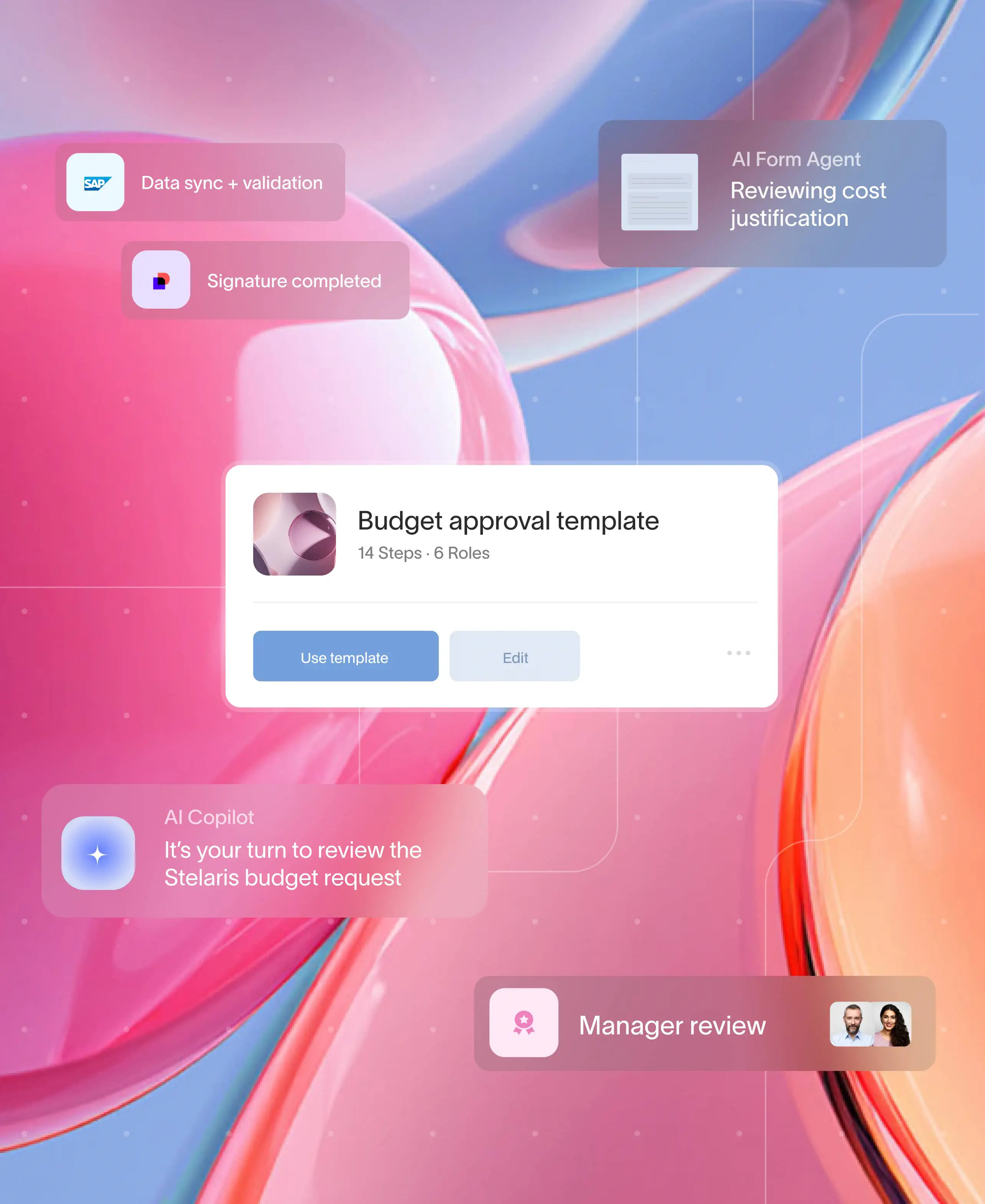
At a glance
Negotiating contracts is one of the most critical yet frustrating parts of doing business. Deals often stall in endless email threads, multiple redlined versions create confusion, and stakeholders lose track of who owes the next response. The longer negotiations take, the greater the risk of losing momentum — or even the deal itself. According to Gartner, the average B2B contract lifecycle takes 20–30 days to close, with negotiation accounting for more than half of that time.
This inefficiency comes at a high cost. Research by World Commerce & Contracting shows poor negotiation practices contribute to up to 9.2% value leakage on contracts. Meanwhile, PwC reports that nearly 40% of executives believe slow negotiations damage client relationships. And Aberdeen Group estimates businesses spend an average of $6,900 in administrative costs per contract during negotiations alone.
A contract negotiation workflow changes this dynamic. Instead of chasing feedback across disconnected channels, businesses can orchestrate every step — from drafting to redlining to approvals — in one clear, auditable flow. The lifecycle of a contract management workflow involves several essential stages including authoring, review, negotiation, approval, signature, centralized storage, performance monitoring, and renewal management. This article explains what a contract negotiation workflow is, why traditional methods fail, the hidden costs of inefficiency, and what to look for in a modern solution. For a broader perspective on how negotiation fits into the full lifecycle, see our complete guide to contract management workflow.
What is a contract negotiation workflow
A contract negotiation workflow is the structured process that governs how agreements move through review, revision, and approval before final execution. An effective contract management workflow fosters efficiency, reduces errors, and maintains compliance with regulatory standards. Unlike ad hoc negotiations conducted over email or shared drives, a defined workflow ensures that:
- Every stakeholder knows when it’s their turn to act.
- Document versions are tracked and updated in one place.
- Approvals are logged for compliance.
- External parties — clients, vendors, or partners — can participate seamlessly.
By moving negotiation out of inboxes and into a structured flow, businesses eliminate bottlenecks and reduce the risk of deals stalling.
Why traditional negotiations break down
Even organizations with strong contract drafting processes often hit roadblocks during negotiation.
Version confusion. A procurement team sends a contract draft to legal for review, while the vendor simultaneously returns their own redlined version. With no single source of truth, both versions circulate in parallel. Teams waste days reconciling discrepancies.
Approval bottlenecks. Legal signs off, but the contract sits in a VP’s inbox for weeks. Because there’s no automated escalation, the process stalls until someone manually follows up.
External delays. Clients or vendors often can’t engage directly with the process. They send edits via email, leading to miscommunication and delays.
Compliance risks. When revisions aren’t logged, it becomes impossible to trace who approved what — exposing the business to disputes or regulatory scrutiny.
These breakdowns don’t just waste time — they introduce risk and strain relationships with clients and partners.
The hidden costs of slow negotiations
Negotiations that drag on for weeks don’t just waste administrative time and contribute to repetitive tasks — they actively harm business outcomes.
- Revenue delays. A contract stuck in negotiation pushes revenue recognition out by weeks or months. For fast-growth companies, this can mean missing quarterly targets.
- Value leakage. Small concessions made in the interest of “closing quickly” — such as discounts or waived terms — add up. Research shows negotiation inefficiencies cause measurable revenue loss.
- Reputational impact. Clients and vendors frustrated by slow negotiations may see the business as disorganized, unprofessional, or difficult to work with.
- Compliance exposure. Poorly tracked revisions or skipped approvals increase the risk of non-compliance, especially in regulated industries.
Contract negotiation automation shortens deal cycles and increases revenue opportunities.
This is why modern organizations are rethinking negotiation not as a back-office activity but as a strategic process that directly impacts growth.
What to look for in a negotiation workflow solution
Not all contract management tools are designed to handle negotiation effectively. Many focus on storage or back-office lifecycle management but leave negotiation in email. Businesses should look for platforms that:
Centralize document collaboration so all revisions and comments are tracked in one place.
Support external stakeholders with a client-facing interface for redlines and approvals.
Enable role-based approvals so legal, finance, and executives can sign off in sequence without confusion.
Provide audit trails to capture every change for compliance.
Deliver intelligent nudges to remind stakeholders when it’s their turn, preventing bottlenecks.
Moxo’s workflow orchestration platform was designed for these multi-party scenarios. Unlike headless or internal-only tools, it provides a client-facing experience where external parties can collaborate securely. By combining automation, audit-ready tracking, and human-in-the-loop approvals, Moxo enables organizations to negotiate contracts faster without sacrificing accountability.
Real-world examples of negotiation workflows
Legal services. Law firms often handle complex negotiations with clients and opposing counsel. Without orchestration, contract terms bounce between inboxes for weeks. With a negotiation workflow, each revision is logged, approvals are clear, and final agreements are executed faster.
Procurement. Supplier agreements typically involve procurement, finance, legal, and external vendors. Orchestration ensures every party has visibility into the latest draft, preventing costly errors from version mix-ups.
Financial services. Loan and vendor agreements must be negotiated with strict compliance oversight. A negotiation workflow provides audit trails and accountability, reducing risk while speeding up execution.
These examples highlight how negotiation is often the longest and most vulnerable stage of the contract management workflow process.
Best practices for contract negotiation workflows
Organizations that streamline negotiations often adopt these practices:
Start with standardized templates. This reduces the amount of redlining required and creates consistency across deals.
Assign clear roles. Define who owns legal review, who approves pricing, and who signs off on risk, so negotiations don’t bounce aimlessly.
Track revisions centrally. Avoid version chaos by housing all changes and comments in one platform.
Automate reminders. Intelligent nudges ensure stakeholders act quickly, particularly external parties who might otherwise cause delays.
Review metrics. Track negotiation timelines and bottlenecks to continuously improve the process.
Standardizing contract templates and clauses is essential for maintaining consistency and reducing the time spent on drafting agreements.
Start with standardized templates. This reduces the amount of redlining required and creates consistency across deals.
Assign clear roles. Define who owns legal review, who approves pricing, and who signs off on risk, so negotiations don’t bounce aimlessly.
Track revisions centrally. Avoid version chaos by housing all changes and comments in one platform.
Automate reminders. Intelligent nudges ensure stakeholders act quickly, particularly external parties who might otherwise cause delays.
Review metrics. Track negotiation timelines and bottlenecks to continuously improve the process.
For organizations managing large contract volumes, these best practices form the basis of an efficient contract workflow that protects revenue and relationships.
Frequently asked questions
What is a contract negotiation workflow?
It is the structured process that manages how contracts move through review, revisions, and approvals before execution, ensuring no step is missed.
Why do contract negotiations take so long?
Negotiations often stall due to version confusion, buried approvals, and delays from external parties who lack direct access to the process.
How can technology improve contract negotiations?
Platforms designed for orchestration centralize revisions, log approvals, and provide client-facing interfaces, making negotiations faster and more transparent.
What features should I look for in a negotiation workflow platform?
Key features include centralized collaboration, external stakeholder access, role-based approvals, audit trails, and automated reminders.
How do negotiation workflows reduce risk?
By tracking every revision and approval, workflows provide full auditability, reducing compliance and legal risks during negotiations.
Can small and mid-sized businesses benefit from negotiation workflows?
Yes. Even organizations with modest contract volumes save significant time and project professionalism by moving negotiations out of email.
Stop letting negotiations stall your deals
When negotiations drag on, revenue is delayed and client trust suffers. A contract negotiation workflow keeps revisions, approvals, and signatures moving in one clear flow. Automating reminders and status alerts helps keep all parties informed during negotiations. Moxo enables businesses to orchestrate negotiations end-to-end with client-facing collaboration, built-in compliance, and intelligent nudges that prevent bottlenecks. Book a 15 minute demo and discover how Moxo can help you close deals faster with a streamlined contract negotiation process.





